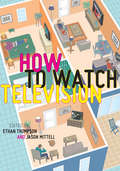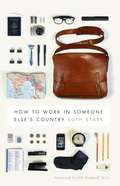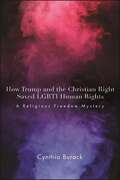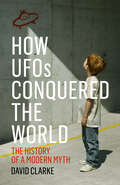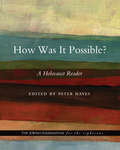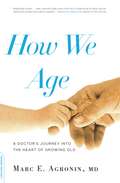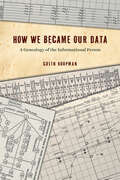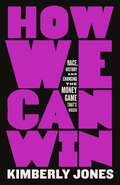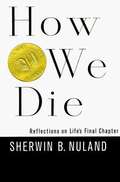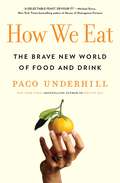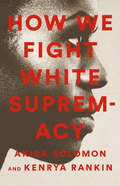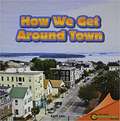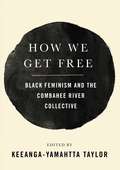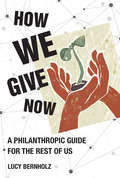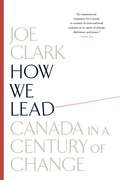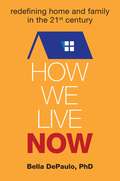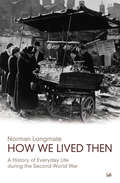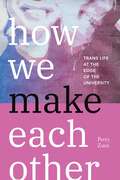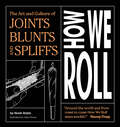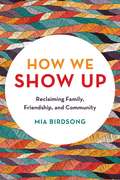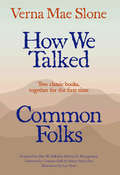- Table View
- List View
How To Watch Television
by Ethan Thompson Jason MittellWe all have opinions about the television shows we watch, but television criticism is about much more than simply evaluating the merits of a particular show and deeming it 'good' or 'bad.' Rather, criticism uses the close examination of a television program to explore that program's cultural significance, creative strategies, and its place in a broader social context. How to Watch Television brings together forty original essays from today's leading scholars on television culture, writing about the programs they care (and think) the most about. Each essay focuses on a particular television show, demonstrating one way to read the program and, through it, our media culture. The essays model how to practice media criticism in accessible language, providing critical insights through analysis--suggesting a way of looking at TV that students and interested viewers might emulate. The contributors discuss a wide range of television programs past and present, covering many formats and genres, spanning fiction and non-fiction, broadcast and cable, providing a broad representation of the programs that are likely to be covered in a media studies course. While the book primarily focuses on American television, important programs with international origins and transnational circulation are also covered. Addressing television series from the medium's earliest days to contemporary online transformations of television, How to Watch Television is designed to engender classroom discussion among television critics of all backgrounds. Read: Introduction / Table of Contents / Sample Essays Online View: Clips from the Essays Visit the Facebook page.
How To Work In Someone Else's Country
by Ruth StarkWorking abroad offers adventure, friendship with people of other cultures, intimate familiarity with exciting places, and opportunities to make real differences in communities. It also presents countless challenges, ranging from packing and staying safe and healthy to balancing project objectives with on-the-ground realities, working with local officials, and forging respectful and productive relationships. These challenges and many more are tackled in "How to Work in Someone Else's Country. " Drawing on thirty years of experience as an international consultant in Africa, Asia, Latin America, and the Pacific, Ruth Stark provides guidance for anybody preparing to work in a foreign country. This easy-to-read guide is enlivened by real-life examples drawn from the author's journals and stories shared by colleagues. Slim enough to fit in a carry-on, this book is sure to come in handy wherever your work takes you.
How Toddlers Learn the Secret Language of Movies
by Cary BazalgetteThis book takes a radically new approach to the well-worn topic of children's relationship with the media, avoiding the "risks and benefits" paradigm while examining very young children's interactions with film and television. Bazalgette proposes a refocus on the learning processes that children must go through in order to understand what they are watching on televisions, phones, or iPads. To demonstrate this, she offers unique insight from research done with her twin grandchildren starting from just before they were two years old, with analysis drawn from the field of embodied cognition to help identify minute behaviours and expressions as signals of emotions and thought processes. The book makes the case that all inquiry into early childhood movie-viewing should be based on the premise that learning–usually self-driven–is taking place throughout.
How Trump and the Christian Right Saved LGBTI Human Rights: A Religious Freedom Mystery (SUNY series in Queer Politics and Cultures)
by Cynthia BurackDuring the Obama administration, Christian conservatives insisted that securing human rights for LGBTI people abroad diminished human rights protections for people of faith. During the 2016 presidential election, the Christian right backed Donald Trump and demanded an end to sexual orientation and gender identity (SOGI) foreign policy. Did the Trump administration move to terminate US advocacy for SOGI human rights? Did Christian conservative US officials and elites do everything in their power to publicize, curb, defund, and undermine US support for SOGI? If not—spoiler alert: they did not—why not? Analyzing SOGI human rights and religious freedom foreign policy, How Trump and the Christian Right Saved LGBTI Human Rights reveals the indifference, mendacity, and political interests at play in Trump's alliance with Christian right elites.
How UFOs Conquered the World: The History of a Modern Myth
by David Clarke“Cover[s] all the major themes of ufology, ranging from lights in the sky to crashed saucers, government cover-ups and alien abductions . . . fascinating.” —Popular Science BooksNeither a credulous work of conspiracy theory nor a skeptical debunking of belief in “flying saucers,” How UFOs Conquered the World explores the origins of UFOs in the build-up to the First World War and how reports of them have changed in tandem with world events, science and culture. The book will also explore the overlaps between UFO belief and religion and superstition.“An insightful, informative and thought-provoking book on UFOs and the UFO culture . . . In the following ten chapters, he writes about his pursuit of the ‘truth’ about UFOs. It is a fascinating journey.” —Skeptic
How Was It Possible?: A Holocaust Reader
by Peter HayesAs the Holocaust passes out of living memory, future generations will no longer come face-to-face with Holocaust survivors. But the lessons of that terrible period in history are too important to let slip past. How Was It Possible?, edited and introduced by Peter Hayes, provides teachers and students with a comprehensive resource about the Nazi persecution of Jews. Deliberately resisting the reflexive urge to dismiss the topic as too horrible to be understood intellectually or emotionally, the anthology sets out to provide answers to questions that may otherwise defy comprehension. This anthology is organized around key issues of the Holocaust, from the historical context for antisemitism to the impediments to escaping Nazi Germany, and from the logistics of the death camps and the carrying out of genocide to the subsequent struggles of the displaced survivors in the aftermath. Prepared in cooperation with the Jewish Foundation for the Righteous, this anthology includes contributions from such luminaries as Jean Ancel, Saul Friedlander, Tony Judt, Alan Kraut, Primo Levi, Robert Proctor, Richard Rhodes, Timothy Snyder, and Susan Zuccotti. Taken together, the selections make the ineffable fathomable and demystify the barbarism underlying the tragedy, inviting readers to learn precisely how the Holocaust was, in fact, possible.
How We Age: A Doctor's Journey into the Heart of Growing Old
by Marc AgroninA young doctorOCOs reflections on his experiences as a nursing-home psychiatrist?with remarkable stories of vitality and growth that transformed his view of aging
How We Became Our Data: A Genealogy of the Informational Person
by Colin KoopmanWe are now acutely aware, as if all of the sudden, that data matters enormously to how we live. How did information come to be so integral to what we can do? How did we become people who effortlessly present our lives in social media profiles and who are meticulously recorded in state surveillance dossiers and online marketing databases? What is the story behind data coming to matter so much to who we are? In How We Became Our Data, Colin Koopman excavates early moments of our rapidly accelerating data-tracking technologies and their consequences for how we think of and express our selfhood today. Koopman explores the emergence of mass-scale record keeping systems like birth certificates and social security numbers, as well as new data techniques for categorizing personality traits, measuring intelligence, and even racializing subjects. This all culminates in what Koopman calls the “informational person” and the “informational power” we are now subject to. The recent explosion of digital technologies that are turning us into a series of algorithmic data points is shown to have a deeper and more turbulent past than we commonly think. Blending philosophy, history, political theory, and media theory in conversation with thinkers like Michel Foucault, Jürgen Habermas, and Friedrich Kittler, Koopman presents an illuminating perspective on how we have come to think of our personhood—and how we can resist its erosion.
How We Became Sensorimotor: Movement, Measurement, Sensation
by Mark PatersonAn engrossing history of the century that transformed our knowledge of the body&’s inner senses The years between 1833 and 1945 fundamentally transformed science&’s understanding of the body&’s inner senses, revolutionizing fields like philosophy, the social sciences, and cognitive science. In How We Became Sensorimotor, Mark Paterson provides a systematic account of this transformative period, while also demonstrating its substantial implications for current explorations into phenomenology, embodied consciousness, the extended mind, and theories of the sensorimotor, the body, and embodiment.Each chapter of How We Became Sensorimotor takes a particular sense and historicizes its formation by means of recent scientific studies, case studies, or coverage in the media. Ranging among a diverse array of sensations, including balance, fatigue, pain, the &“muscle sense,&” and what Maurice Merleau-Ponty termed &“motricity,&” Paterson&’s analysis moves outward from the familiar confines of the laboratory to those of the industrial world and even to wild animals and their habitats. He uncovers important stories, such as how forgotten pain-measurement schemes transformed criminology, or how Penfield&’s outmoded concepts of the sensory and motor homunculi of the brain still mar psychology textbooks.Complete with original archival research featuring illustrations and correspondence, How We Became Sensorimotor shows how the shifting and sometimes contested historical background to our understandings of the senses are being extended even today.
How We Can Win: Race, History and Changing the Money Game That's Rigged
by Kimberly JonesAn Amazon Editors' Pick: HistoryA breakdown of the economic and social injustices facing Black people and other marginalized citizens inspired by political activist Kimberly Jones' viral video, “How Can We Win.”“So if I played four hundred rounds of Monopoly with you and I had to play and give you every dime that I made, and then for fifty years, every time that I played, if you didn't like what I did, you got to burn it like they did in Tulsa and like they did in Rosewood, how can you win? How can you win?"When Kimberly Jones declared these words amid the protests spurred by the murder of George Floyd, she gave a history lesson that in just over six minutes captured the economic struggles of Black people in America. Within days the video had been viewed by millions of people around the world, riveted by Jones’s damning—and stunningly succinct—analysis of the enduring disparities Black Americans face.In How We Can Win, Jones delves into the impacts of systemic racism and reveals how her formative years in Chicago gave birth to a lifelong devotion to justice. Here, in a vital expansion of her declaration, she calls for Reconstruction 2.0, a multilayered plan to reclaim economic and social restitutions—those restitutions promised with emancipation but blocked, again and again, for more than 150 years. And, most of all, Jones delivers strategies for how we can effect change as citizens and allies while nurturing ourselves—the most valuable asset we have—in the fight against a system that is still rigged.
How We Die: Reflections on Life's Final Chapter
by Sherwin B. NulandAttempting to demythologize the process of dying, Nuland explores how we shall die, each of us in a way that will be unique. Through particular stories of dying--of patients, and of his own family--he examines the seven most common roads to death: old age, cancer, AIDS, Alzheimer's, accidents, heart disease, and strokes, revealing the facets of death's multiplicity. "It's impossible to read How We Die without realizing how earnestly we have avoided this most unavoidable of subjects, how we have protected ourselves by building a cultural wall of myths and lies. I don't know of any writer or scientist who has shown us the face of death as clearly, honestly and compassionately as Sherwin Nuland does here."--James Gleick.<P><P> *** Originally published in 1994 and on the New York Times bestseller list for weeks, this reprint includes an in-depth 2010 post-epilogue epilogue by the author. <P> Winner of the National Book Award
How We Eat: The Brave New World of Food and Drink
by Paco UnderhillAn &“eye-opening&” (Kirkus Reviews) and timely exploration of how our food—from where it&’s grown to how we buy it—is in the midst of a transformation, showing how this is our chance to do better, for us, for our children, and for our planet, from a global expert on consumer behavior and bestselling author of Why We Buy.Our food system is undergoing a total transformation that impacts how we produce, get, and consume our food. Market researcher and bestselling author Paco Underhill—hailed by the San Francisco Chronicle as &“a Sherlock Holmes for retailers&”—reveals where our eating and drinking lives are heading in his &“delectable&” (Michael Gross, New York Times bestselling author of 740 Park) book, How We Eat. In this upbeat, hopeful, and witty approach, How We Eat reveals the future of food in surprising ways. Go to the heart of New York City where a popular farmer&’s market signifies how the city is getting country-fied, or to cool Brooklyn neighborhoods with rooftop farms. Explore the dreaded supermarket parking lot as the hub of innovation for grocery stores&’ futures, where they can grow their own food and host community events. Learn how marijuana farmers, who have been using artificial light to grow a crop for years, have developed a playbook so mainstream merchants like Walmart and farmers across the world can grow food in an uncertain future. Paco Underhill is the expert behind the most prominent brands, consumer habits, and market trends and the author of multiple highly acclaimed books, including Why We Buy. In How We Eat, he shows how food intersects with every major battle we face today, from political and environmental to economic and racial, and invites you to the market to discover more.
How We Fight White Supremacy: A Field Guide to Black Resistance
by Kenrya Rankin Akiba SolomonThis celebration of Black resistance, from protests to art to sermons to joy, offers a blueprint for the fight for freedom and justice -- and ideas for how each of us can contribute Many of us are facing unprecedented attacks on our democracy, our privacy, and our hard-won civil rights. If you're Black in the US, this is not new. As Colorlines editors Akiba Solomon and Kenrya Rankin show, Black Americans subvert and resist life-threatening forces as a matter of course. In these pages, leading organizers, artists, journalists, comedians, and filmmakers offer wisdom on how they fight White supremacy. It's a must-read for anyone new to resistance work, and for the next generation of leaders building a better future.Featuring contributions from:Ta-Nehisi CoatesTarana BurkeHarry Belafonteadrienne maree brownAlicia GarzaPatrisse Khan-CullorsReverend Dr. Valerie BridgemanKiese LaymonJamilah Lemieux Robin DG KelleyDamon YoungMichael ArceneauxHanif AbdurraqibDr. Yaba BlayDiamond StingilyAmanda Seales Imani PerryDenene MillnerKierna MayoJohn JenningsDr. Joy Harden BradfordTongo Eisen-Martin
How We Get Around Town (Infomax Common Core Readers)
by April LeeExplains the different ways people can get around town, including walking, biking, and driving.
How We Get Free: Black Feminism and the Combahee River Collective
by Keeanga-Yamahtta TaylorThe Combahee River Collective, a path-breaking group of radical black feminists, was one of the most important organizations to develop out of the antiracist and women's liberation movements of the 1960s and 70s. In this collection of essays and interviews edited by activist-scholar Keeanga-Yamahtta Taylor, founding members of the organization and contemporary activists reflect on the legacy of its contributions to Black feminism and its impact on today's struggles.
How We Get Free: Black Feminism and the Combahee River Collective
by Keeanga-Yamahtta TaylorBlack feminists remind us “that America’s destiny is inseparable from how it treats [black women] and the nation ignores this truth at its peril” (The New York Review of Books). <P><P>Winner of the 2018 Lambda Literary Award for LGBTQ Nonfiction <P><P> “If Black women were free, it would mean that everyone else would have to be free.” —Combahee River Collective Statement <P><P> The Combahee River Collective, a path-breaking group of radical black feminists, was one of the most important organizations to develop out of the antiracist and women’s liberation movements of the 1960s and 70s. In this collection of essays and interviews edited by activist-scholar Keeanga-Yamahtta Taylor, founding members of the organization and contemporary activists reflect on the legacy of its contributions to Black feminism and its impact on today’s struggles. <P><P>“A striking collection that should be immediately added to the Black feminist canon.” —Bitch Media “An essential book for any feminist library.” —Library Journal “As white feminism has gained an increasing amount of coverage, there are still questions as to how black and brown women’s needs are being addressed. This book, through a collection of interviews with prominent black feminists, provides some answers.” —The Independent “For feminists of all kinds, astute scholars, or anyone with a passion for social justice, How We Get Free is an invaluable work.” —Ethnic and Racial Studies Journal
How We Give Now: A Philanthropic Guide for the Rest of Us
by Lucy BernholzFrom Go Fund Me to philanthropy: the everyday ways that we can give our money, our time, and even our data to help our communities and seek justice.In How We Give Now, Lucy Bernholz shows that philanthropy is more than writing a check and claiming a tax deduction. For most of us--the non-wealthy givers--philanthropy can be a way of living our values and fully participating in society. We give in all kinds of ways--shopping at certain businesses, canvassing for candidates, donating money, and making conscious choices with our retirement funds. We give our cash, our time, and even our data to make the world a better place. Bernholz takes readers on a tour of the often-overlooked worlds of participatory philanthropy, learning from a diverse group of forty resourceful givers. Donating our digitized personal data is an emerging form of philanthropy, and Bernholz describes safe, equitable, and effective ways of doing so--giving genetic data for medical research through a nonprofit genetics organization rather than a commercial one, for example, or contributing photographs to an online archive like the Densho Digital Repository, which documents America's internment of 120,000 Americans of Japanese descent. Bernholz tells us to "follow the money," however, when we're asked to "add a dollar" to our total at the cash register, or when we buy a charity-branded product; it's more effective to give directly than to give while shopping. Giving is a form of participation. Philanthropy by the rest of us--across geographies and cultural traditions--begins with and builds on active commitment to our communities.
How We Hope: A Moral Psychology
by Adrienne M. MartinWhat exactly is hope and how does it influence our decisions? In How We Hope, Adrienne Martin presents a novel account of hope, the motivational resources it presupposes, and its function in our practical lives. She contends that hoping for an outcome means treating certain feelings, plans, and imaginings as justified, and that hope thereby involves sophisticated reflective and conceptual capacities. Martin develops this original perspective on hope--what she calls the "incorporation analysis"--in contrast to the two dominant philosophical conceptions of hope: the orthodox definition, where hoping for an outcome is simply desiring it while thinking it possible, and agent-centered views, where hoping for an outcome is setting oneself to pursue it. In exploring how hope influences our decisions, she establishes that it is not always a positive motivational force and can render us complacent. She also examines the relationship between hope and faith, both religious and secular, and identifies a previously unnoted form of hope: normative or interpersonal hope. When we place normative hope in people, we relate to them as responsible agents and aspire for them to overcome challenges arising from situation or character. Demonstrating that hope merits rigorous philosophical investigation, both in its own right and in virtue of what it reveals about the nature of human emotion and motivation, How We Hope offers an original, sustained look at a largely neglected topic in philosophy.
How We Lead: Canada in a Century of Change
by Joe ClarkA passionate argument for Canada's reassertion of its place on the world stage, from a former prime minister and one of Canada's most respected political figures. In the world that is taking shape, the unique combination of Canada's success at home as a diverse society and its reputation internationally as a sympathetic and respected partner consititute national assets that are at least as valuable as its natural resource wealth. As the world becomes more competitive and complex, and the chances of deadly conflict grow, the example and the initiative of Canada can become more important than they have ever been. That depends on its people: assets have no value if Canadians don't recognize or use them, or worse, if they waste them. A more effective Canada is not only a benefit to itself, but to its friends and neighbours. And in this compelling examination of what it as a nation has been, what it has become and what it can yet be to the world, Joe Clark takes the reader beyond formal foreign policy and looks at the contributions and leadership offered by Canada's most successful individuals and organizations who are already putting these uniquely Canadian assets to work internationally.
How We Live Now
by Bella DepauloA close-up examination and exploration, How We Live Now challenges our old concepts of what it means to be a family and have a home, opening the door to the many diverse and thriving experiments of living in twenty-first century America.Across America and around the world, in cities and suburbs and small towns, people from all walks of life are redefining our "lifespaces"--the way we live and who we live with. The traditional nuclear family in their single-family home on a suburban lot has lost its place of prominence in contemporary life. Today, Americans have more choices than ever before in creating new ways to live and meet their personal needs and desires. Social scientist, researcher, and writer Bella DePaulo has traveled across America to interview people experimenting with the paradigm of how we live. In How We Live Now, she explores everything from multi-generational homes to cohousing communities where one's "family" is made up of friends and neighbors to couples "living apart together" to single-living, and ultimately uncovers a pioneering landscape for living that throws the old blueprint out the window. Through personal interviews and stories, media accounts, and in-depth research, How We Live Now explores thriving lifespaces, and offers the reader choices that are freer, more diverse, and more attuned to our modern needs for the twenty-first century and beyond.
How We Lived Then: History of Everyday Life During the Second World War, A
by Norman LongmateAlthough nearly 90% of the population of Great Britain remained civilians throughout the war, or for a large part of it, their story has so far largely gone untold. In contrast with the thousands of books on military operations, barely any have concerned themselves with the individual's experience. The problems of the ordinary family are barely ever mentioned - food rationing, clothes rationing, the black-out and air raids get little space, and everyday shortages almost none at all. This book is an attempt to redress the balance; to tell the civilian's story largely through their own recollections and in their own words.
How We Make Each Other: Trans Life at the Edge of the University
by Perry ZurnTrans people have always lived in the cracks of institutions—and the university is no exception. In How We Make Each Other, Perry Zurn tells the stories of how trans people make and live their lives at the edges of the university in ways that sometimes lead to policy change but always leave participants and institutions different than they were before. Using the Five Colleges in Massachusetts as a case study, Zurn notes that Amherst College, Hampshire College, Mount Holyoke College, Smith College, and the University of Massachusetts, Amherst, have been at the forefront of developing trans-inclusive policies in higher education, often in response to student organizing. Zurn focuses on the stories of trans students, staff, faculty, and community members within and alongside these institutions, exploring how they have built themselves and each other. Drawing on official archives as well as over 100 interviews, Zurn shows how trans people in the Five Colleges have made history, forged resistance habits, and cultivated hope.
How We Roll: The Art and Culture of Joints, Blunts, and Spliffs
by Noah RubinFrom rolling techniques to ast-roll-ology, interviews to do's and don'ts, quizzes to charts, this lively illustrated guide to all things joints has something for potheads and casual cannabis smokers alike. From the classic joint to The Scorpion, The Braid, The Holy Cross and beyond, How We Roll brings you the best and most important rolling techniques for your favorite herbal concoction, along with interviews, quizzes, charts, and eye-catching original art throughout. Exploring the many unique approaches to rolling through clever illustrations and clear instructions, How We Roll offers something new for every kind of smoker. Featuring insightful interviews with notable cannabis lovers like Wiz Khalifa, Dawn Richard, and Tommy Chong, explorations of rolling culture around the world, and tips and tricks for rolling an exceptional j, How We Roll is the perfect book for any weed connoisseur.GREAT GIFT: A must-have for potheads and causal smokers alikeACCESSIBLE AND EYE-CATCHING: Eye-catching art and design make this comprehensive guide to joints a unique and delectable gift for any cannabis loverEXPERT AUTHOR: Funny but authoritative author who provides a rich and well-rounded look at all things jointsHELPFUL CONTENT: Over 20 ways to roll a joint, with step-by-step instructions Perfect for:Cannabis enthusiastsFans of pot cultureJoint smokers
How We Show Up: Reclaiming Family, Friendship, and Community
by Mia BirdsongAn Invitation to Community and Models for ConnectionAfter almost every presentation activist and writer Mia Birdsong gives to executives, think tanks, and policy makers, one of those leaders quietly confesses how much they long for the profound community she describes. They have family, friends, and colleagues, yet they still feel like they're standing alone. They're "winning" at the American Dream, but they're lonely, disconnected, and unsatisfied.It seems counterintuitive that living the "good life"--the well-paying job, the nuclear family, the upward mobility--can make us feel isolated and unhappy. But in a divided America, where only a quarter of us know our neighbors and everyone is either a winner or a loser, we've forgotten the key element that helped us make progress in the first place: community. In this provocative, groundbreaking work, Mia Birdsong shows that what separates us isn't only the ever-present injustices built around race, class, gender, values, and beliefs, but also our denial of our interdependence and need for belonging. In response to the fear and discomfort we feel, we've built walls, and instead of leaning on each other, we find ourselves leaning on concrete.Through research, interviews, and stories of lived experience, How We Show Up returns us to our inherent connectedness where we find strength, safety, and support in vulnerability and generosity, in asking for help, and in being accountable. Showing up--literally and figuratively--points us toward the promise of our collective vitality and leads us to the liberated well-being we all want.
How We Talked and Common Folks
by Verna Mae SloneIn these two classic memoirs, the beloved Appalachian author shares a rare and vibrant look at the life and culture of her rural Kentucky home.A free-form combination of glossary and memoir, How We Talked is a timeless piece of literature that uses native expressions to depict everyday life in Caney Creek, Kentucky. In addition to phrases and their meanings, the book contains sections on the customs and wisdom of Slone's community, a collection of children's rhymes, and stories and superstitions unique to Appalachia.Originally published in 1979, Common Folks documents Slone's way of life in Pippa Passes, Kentucky, and expands on such diverse topics as family pets, coal mining, education, and marriage. Slone's firsthand account of this unique heritage draws readers into her hill-circled community and allows them to experience a lifestyle that is nearly forgotten.Whether Slone is writing about the particulars of Appalachian folk medicine or the universal experiences of family life, her deep insight and eye for evocative detail make for compelling reading. Published together for the first time, How We Talked and Common Folks celebrate the spirit of an acclaimed Appalachian writer.
